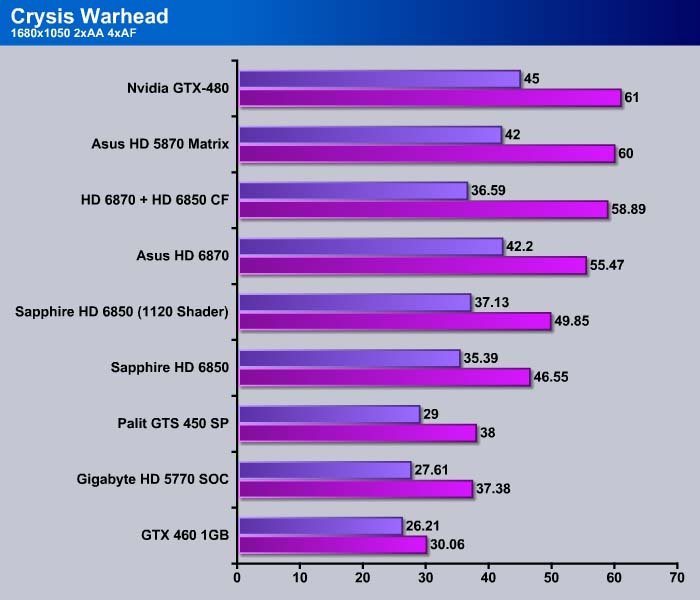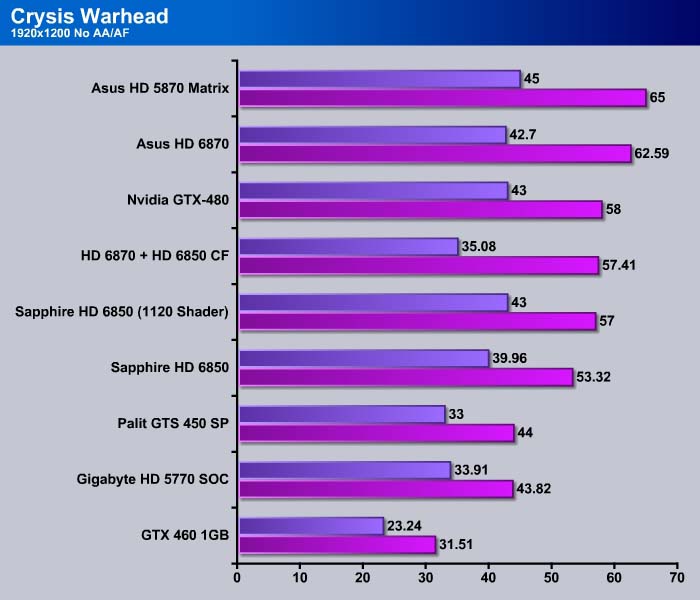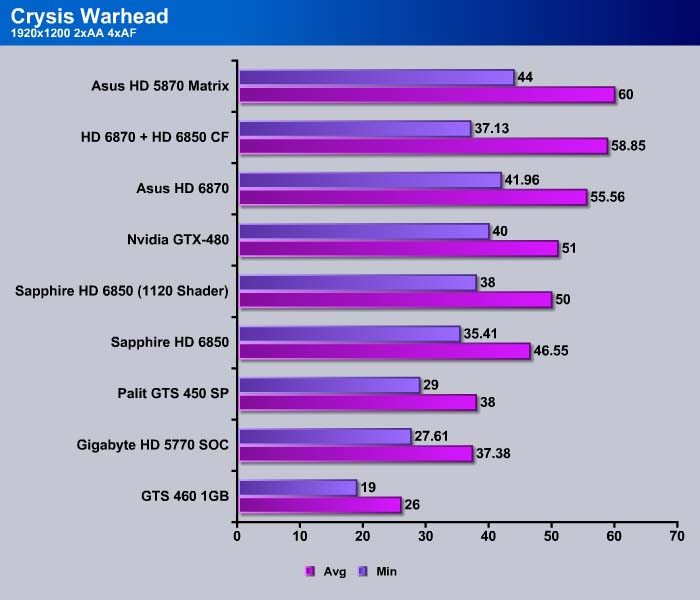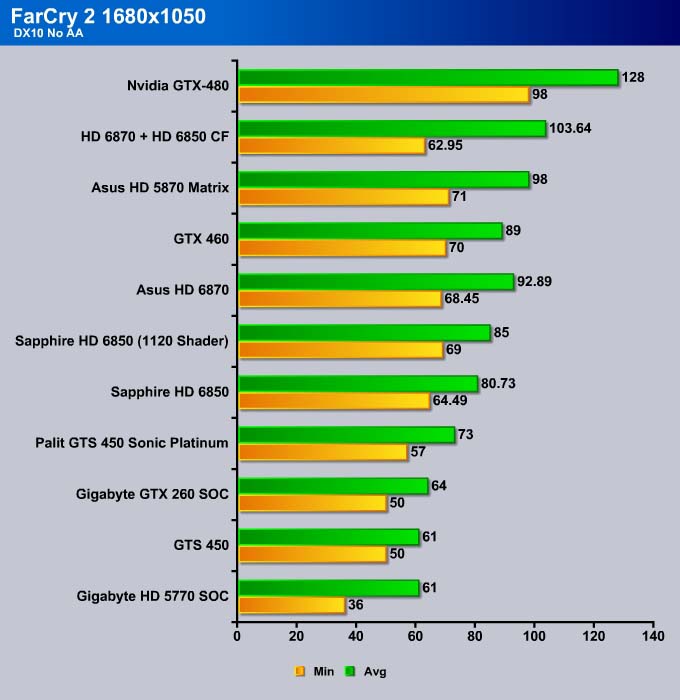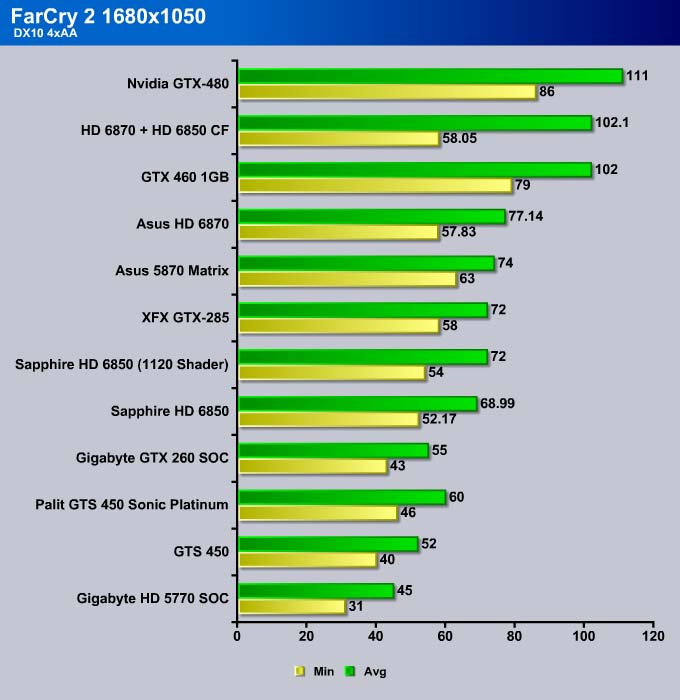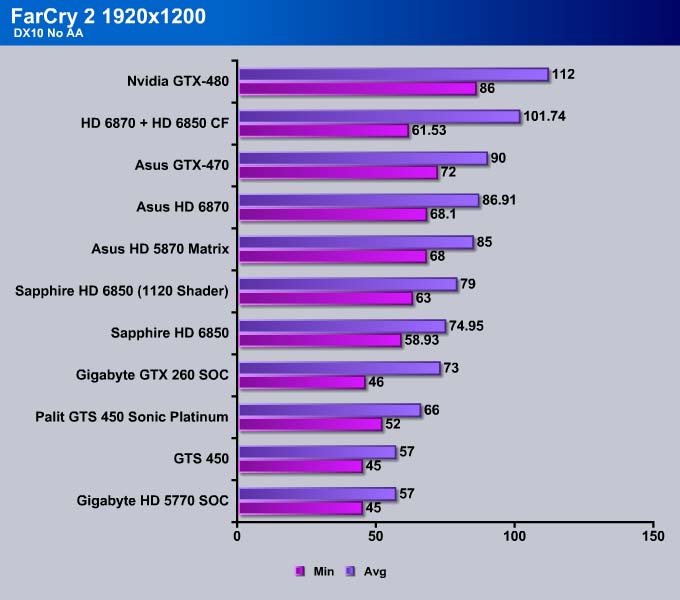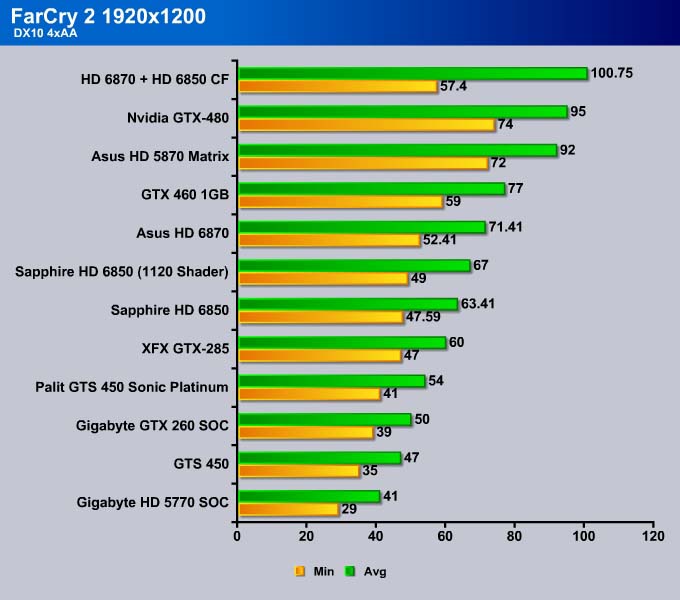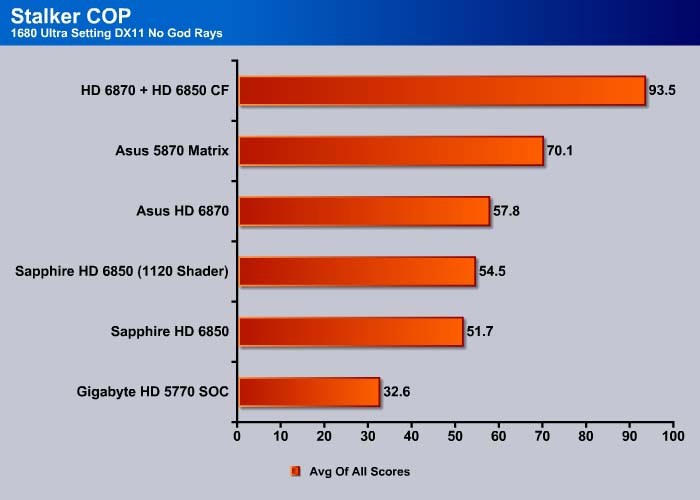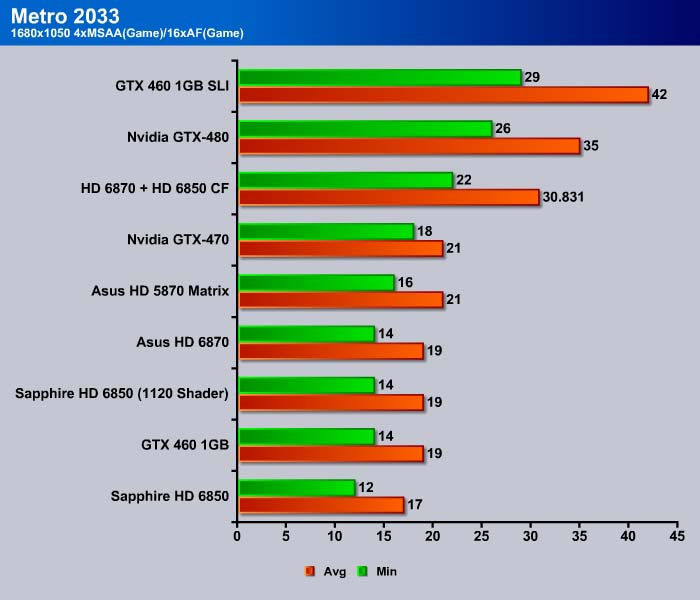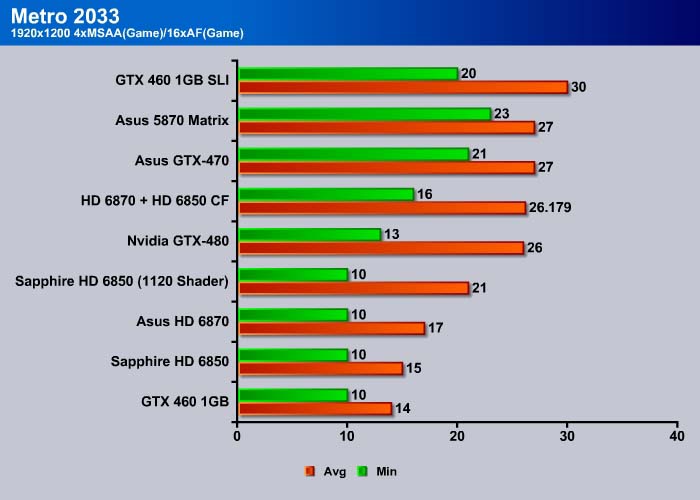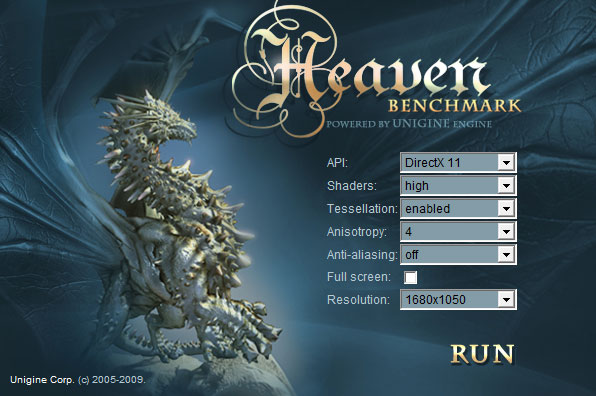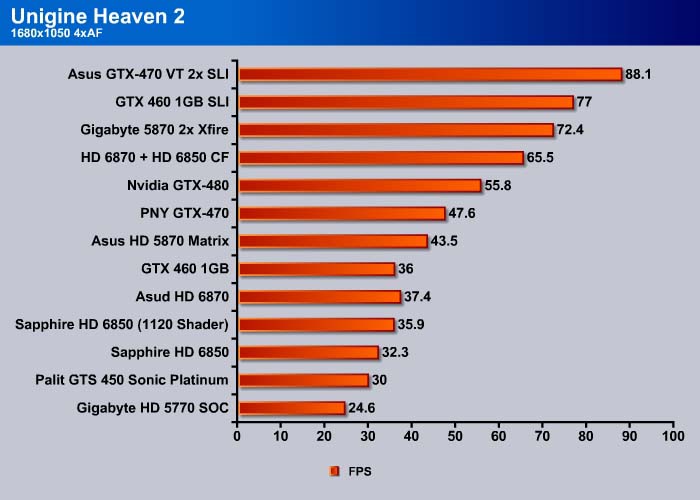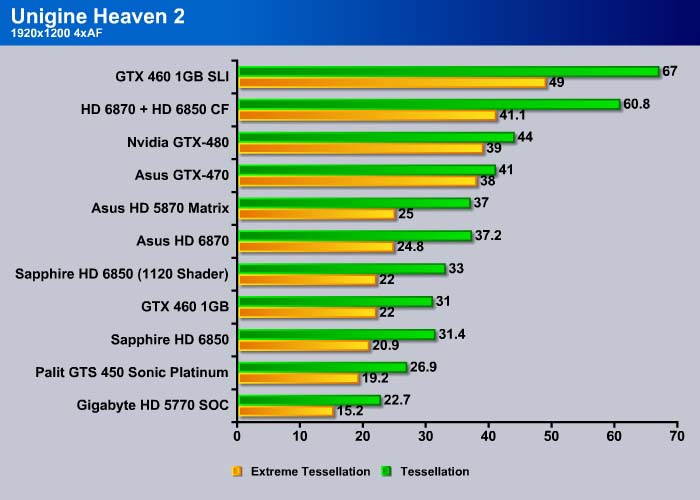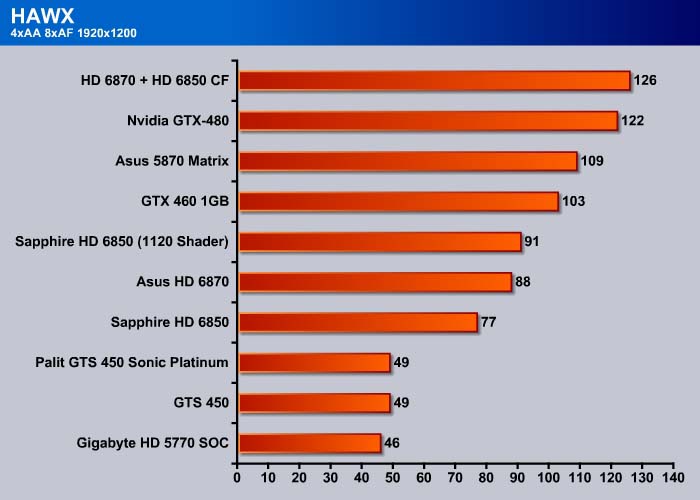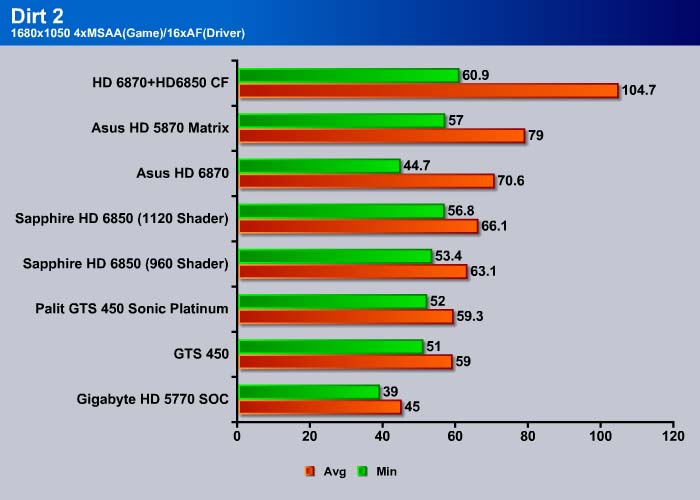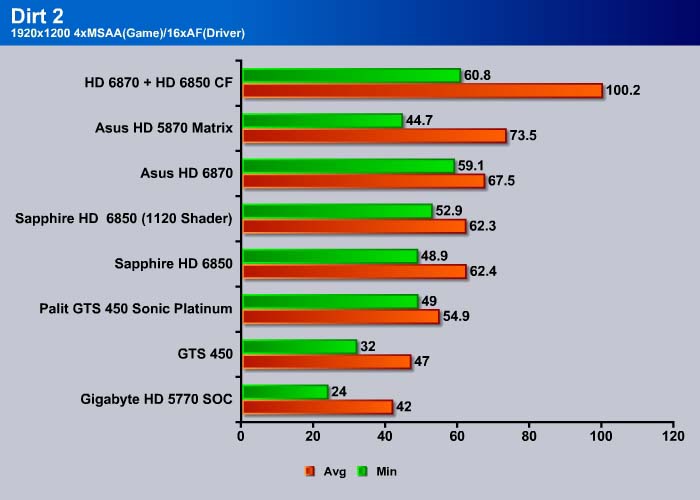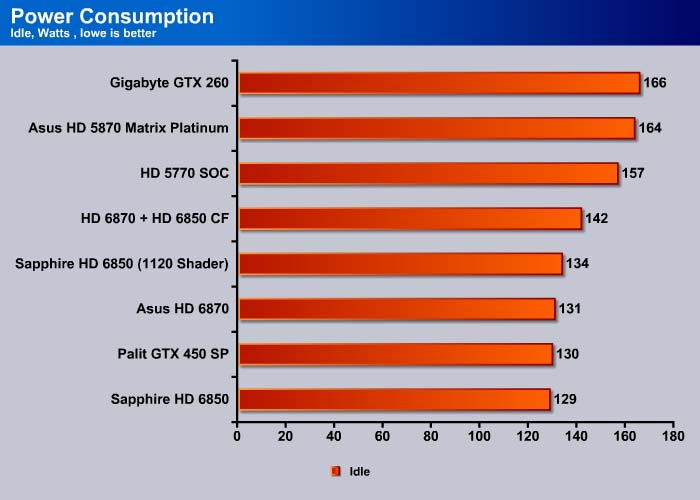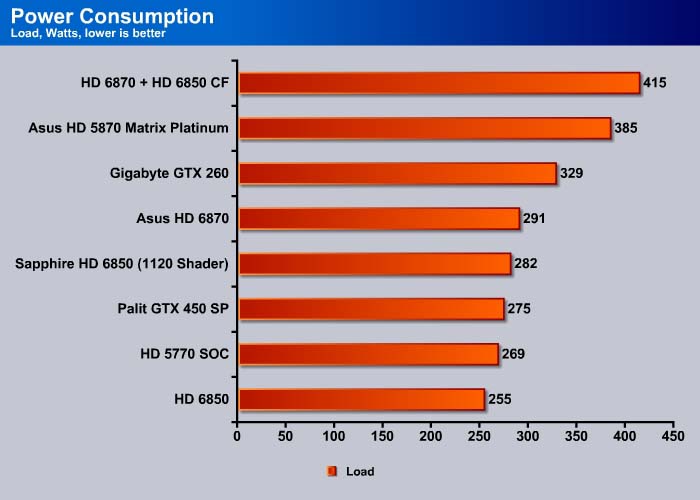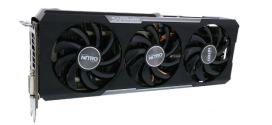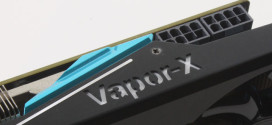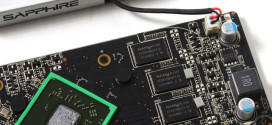We have retested the Sapphire HD 6850 with 960 shader unit and compare it against the card with 1120 shader unit. How does the retail card compare against the card with more shader unit? Let’s find out and also find out how the cards perform in CrossFireX.
introduction
When AMD launched their Radeon HD6xxx series, we did a review of the Sapphire HD6850. Soon after, we found out that the review sample sent to us contained 1120 shader units instead of the 960 shader units that AMD prescribed for the HD6850. We quickly contacted Sapphire, and confirmed that the review sample did indeed contain 1120 shaders. We did what any reputable product analyst would do, and shipped our review sample back to Sapphire for a retail version of the HD6850 so we could rerun our benchmarks and obtain an accurate result.
Asus HD 5870 Matrix, Asus HD 6870 and Sapphire HD 6850 (top to bottom)
After slaving over hours of retests, we have compiled results of the retail version of the HD 6850. Our results shows that the 1120 shader version of the HD 6850 often offers about 5% better performance compared to the 960 unit retail HD 6850. However, the card also consumes about 30 watts more power, almost as much as the HD 6870, which offers about 15~20% greater performance over the reference HD 6850 (960 shaders).
Since we have more time to play with the cards, we decided to throw in the CrossFire performance by pairing an HD 6870 with an HD 6850. Putting the cards in CrossFire produces about 40~50% performance gain over the single HD 6870. The power consumption is also pretty impressive with 415 watts of power usage under load.
TESTING & METHODOLOGY
To test the Sapphire HD6850 we did a fresh load of Windows 7 Ultimate, applied all the updates we could find, installed the latest motherboard drivers for the Gigabyte EX58-UD4P, updated the BIOS, and loaded our test suite. We didn’t load graphic drivers because we wanted to pause to clone the HD with the fresh load of Windows 7 without graphic drivers. That way we have a complete OS load with testing suite and it’s not contaminated with GPU drivers. Should we need to switch GPU’s or run CrossFire, later all we have to do is clone our drive and install GPU drivers and we are good to go.
We ran each test a total of 3 times and report the average here. In the case of a screenshot of a benchmark we ran the benchmark 3 times, tossed out the high and low and post the median result from the benchmark. Any erroneous results were discarded and the test was rerun.
Test Rig
| Test Rig | |
| Case Type | None |
| CPU | Intel Core i7 920 |
| Motherboard | Gigabyte EX58-UD4P |
| Ram | Kingstone HyperX 1600 |
| CPU Cooler | Prolimatech Megahalem |
| Hard Drives | Seagate 7200.11 1.5 TB |
| Optical | None |
| GPU | Asus HD 6870 (EAH6870) Sapphire HD 6850 1120 shader unit Sapphire HD 6850 960 shader unit Gigabyte HD 5770 Super Overclock Asus HD 5870 Matrix Platinum GTX 460 1GB Palit GTS 450 Sonic Platinum Drivers for Nvidia GPU’s 260.89 Drivers for ATI GPU’s 10.10 |
| Case Fans | 120mm Fan cooling the MOSFETs and CPU |
| Docking Stations | None |
| Testing PSU | Cooler Master UCP 900W |
| Legacy | None |
| Mouse | Microsoft Intellimouse |
| Keyboard | Logitech Keyboard |
| Speakers | None |
Synthetic Benchmarks & Games
| Synthetic Benchmarks & Games | |
| 3DMark Vantage | |
| HAWX | |
| Crysis v. 1.2 | |
| Dirt 2 | |
| FarCry 2 | |
| Stalker COP | |
| Crysis Warhead | |
| Unigine Heaven v.2.0 | |
| Metro 2033 | |
Our benchmarks are very comprehensive, including DX9, DX10, DX11, and Tessellation. We wanted as wide a representative sample as possible in the time available.
Crysis v. 1.21

Crysis was the most highly anticipated game to hit the market in the last several years. Crysis is based on the CryENGINE™ 2 developed by Crytek. The CryENGINE™ 2 offers real time editing, bump mapping, dynamic lights, network system, integrated physics system, shaders, shadows, and a dynamic music system, just to name a few of the state-of-the-art features that are incorporated into Crysis. As one might expect with this number of features, the game is extremely demanding of system resources, especially the GPU. We expect Crysis to be a primary gaming benchmark for many years to come.
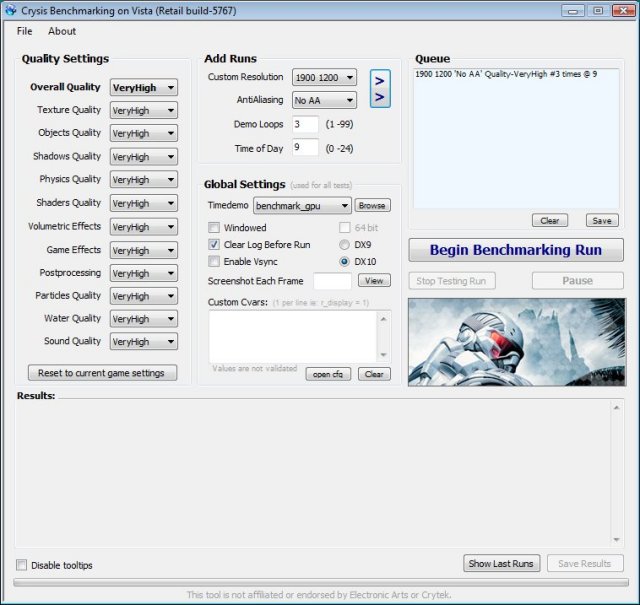
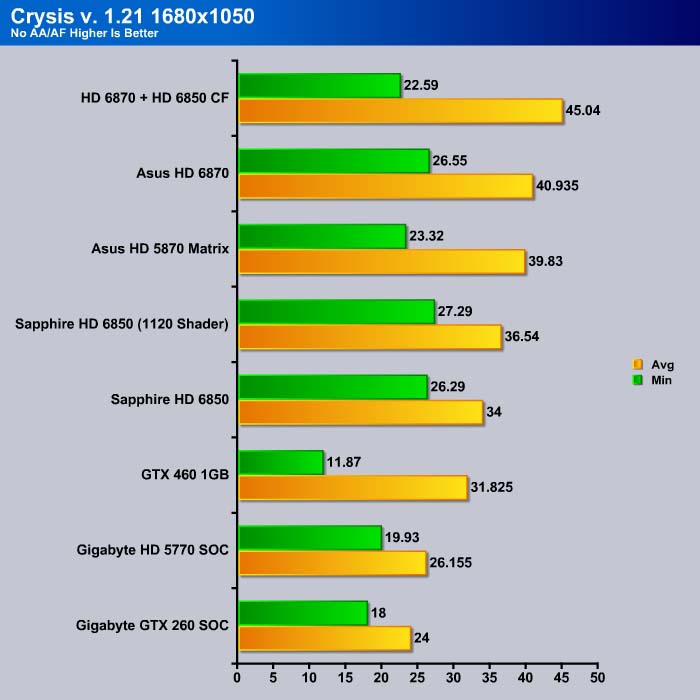

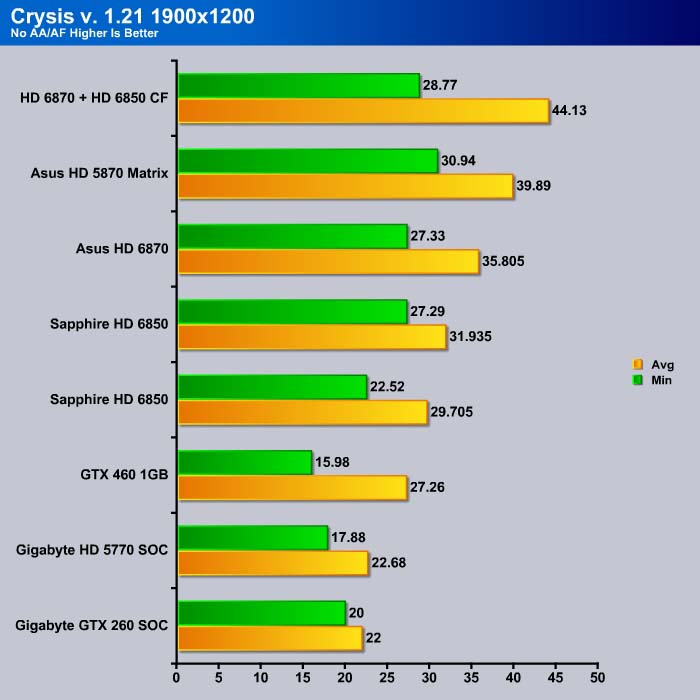
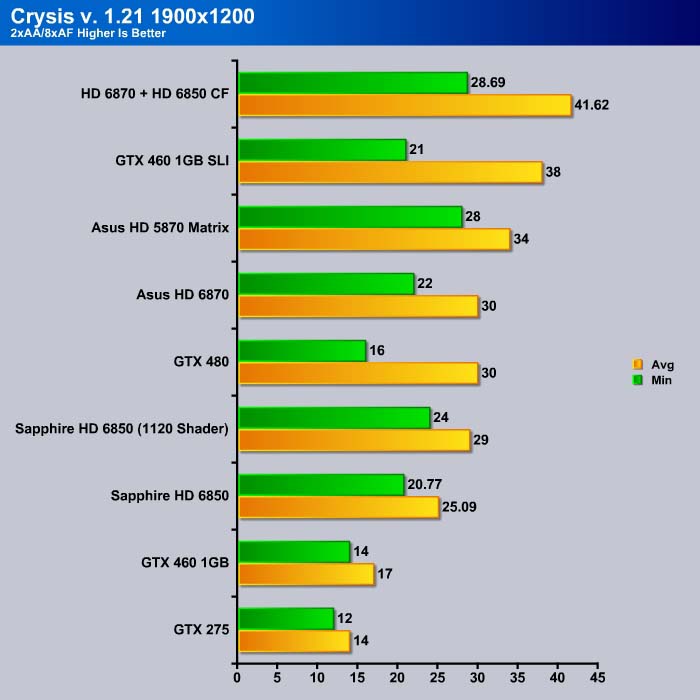
While the single HD 6870 is unable to out-perform the HD 5870 at high resolution with AA and AF enabled, the CrossFire setup consisting of the HD 6870 and HD 6850 does out-perform the HD 5870 with 20% performance gain. In addition, the CrossFire combination also yields a better performance than the GTX 460’s in SLI.
CRYSIS WARHEAD
Crysis Warhead is the much anticipated standalone expansion pack to Crysis, featuring an updated CryENGINE™ 2 with better optimization. It was one of the most anticipated titles of 2008.


Crysis Warhead shows that the extra shaders on the 1120 unit HD 6850 boost the performance by an average 5~7%. The HD 6870, however, shows a much more promising performance gain of 15~20% over the retail HD 6850.
Quite surprisingly, in Crysis Warhead, the CrossFire setup of the HD 6870 and HD 6850 failed to show any performance gain in both 1680×1050 and 1920×1080 resolutions without AA or AF. In fact, the cards show even lower score than the single HD 6870. Enabling the AA and AF shows the benefit of a CrossFire setup, showing 5~7% performance gain over the HD 6870. Nonetheless, it appears that Crysis Warhead does not really take the advantage of the second card as much as other games.
Far Cry 2
Far Cry 2, released in October 2008 by Ubisoft, was one of the most anticipated titles of the year. It’s an engaging state-of-the-art First Person Shooter set in an un-named African country. Caught between two rival factions, you’re sent to take out “The Jackal”. Far Cry 2 ships with a full featured benchmark utility and it is one of the most well designed, well thought out game benchmarks we’ve ever seen. One big difference between this benchmark and others is that it leaves the game’s AI (Artificial Intelligence) running while the benchmark is being performed.
 The Settings we use for benchmarking FarCry 2
The Settings we use for benchmarking FarCry 2
The HD 6850 falls behind the GTX 460 in Far Cry 2. Here, the GTX 460 1GB offers a 20% performance gain over the HD 6850. The 1120 shader version offers only 3~6% performance gain over the reference HD 6850. The HD 6870 has about 10% performance gain over the reference HD 6850 and 5% gain over the 1120 shader version.
Pairing up the HD 6870 and HD 6850 in CrossFire allows the setup to overtake the GTX 460, and even the GTX 480, especially in the 1920×1200 resolution with 4xAA enabled. At a resolution of 1680×1050, the GTX 480 still comes out on top. Far Cry 2 seems to take advantage of the more efficient shader power at higher resolutions.
S.T.A.L.K.E.R.: CALL OF PRIPYAT
Call of Pripyat is the latest addition to the S.T.A.L.K.E.R. franchise. S.T.A.L.K.E.R. has long been considered the thinking man’s shooter, because it gives the player many different ways of completing the objectives. The game includes new advanced DirectX 11 effects as well as the continuation of the story from the previous games.

Let’s start by comparing the AMD cards when we took the God Rays (Sun Shafts) out of the equation.
There is about a 5% increase between the reference HD 6850 with 960 shaders to the 1120 shader version. The same result can also be seen with the 1120 shader unit HD 6850 and the HD 6870. The HD 5870 still has an advantage here, with 20% performance gain over the HD 6870, but our CrossFire combination is capable of offering 33% over the HD 5870.
At 1920×1080, the difference between the 960 shader unit and the 1120 shader unit is only 5%, while the HD 6870 is able to yield 10% performance gain over the 1120 shader card.
A setup of the HD 6870 and the HD 6850 together in CrossFire out-performs HD 5870 in CrossFire. Still, the Nvidia GTX 470 in SLI shows a 17% gain over our CrossFire combination.
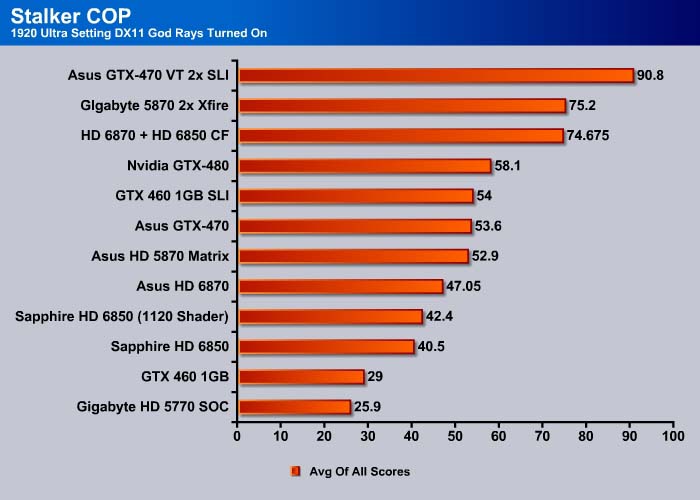
Metro 2033
Metro 2033 is an action-oriented video game with a combination of survival horror, and first-person shooter elements. The game is based on the novel Metro 2033 by Russian author Dmitry Glukhovsky.
The enemies that the player encounters range from human renegades to giant mutated rats and even paranormal forces known only as “The Dark Ones”. Players frequently have to defend themselves with makeshift combination’s of different weapons, e.g a revolver with a sniper scope attached.
Ammunition is also scarce, and the more rare Military Grade bullets are used as currency (to purchase supplies and guns), or in combat as a last resort, giving an added damage boost, forcing the player to hoard supplies.
The game lacks a health meter, relying on audible heart rate and blood spatters to show the player what state they are in and how much damage was done. A gas mask must be worn at all times when exploring the surface due to the harsh air and radiation. There is no on-screen indicator to tell how long the player has until the gas mask’s filters begin to fail, so players must set a wrist watch, and continue to check it every time they wish to know how long they have until their oxygen runs out, requiring the player to replace the filter (found throughout the game). The gas mask also indicates damage in the form of visible cracks, warning the player when a new mask is needed. The game does feature traditional HUD elements, however, such as an ammunition indicator and a list of how many gas mask filters and adrenaline shots remain.
The performance of the HD 6870 and the 1120 shader HD 6850 is almost identical in this test. This is expected because Metro 2033 is a shader-intensive game. The loss of shaders on the HD 6000 series has an impact on the performance, as we can see the HD 5870 pull ahead with 20% better results as compared to the HD 6000 series.
Compared to the GTX 460 1GB, the HD 6870 performs quite well with 30% performance gain. However, the HD 6870 cannot compete against the GTX 470.
Unigine Heaven 2.0
Unigine Heaven is a benchmark program based on Unigine Corp’s latest engine, Unigine. The engine features DirectX 11, Hardware tessellation, DirectCompute, and Shader Model 5.0. All of these new technologies combined with the ability to run each card through the same exact test means this benchmark should be in our arsenal for a long time.
The settings we used in Unigine Heaven
At 1680×1050 and normal tessellation, the ASUS HD 6870 manages to beat out the GTX 460 1GB, but still falls behind the HD 5870 and the GTX 470.
With the same nubmer of shaders, the HD 6870 from ASUS is able to score 10% higher performance than the HD 6850, and comes close to the HD 5870. The improvements to the tessellation engine on the HD 6870 can be clearly seen here. While the HD 6870 is able to come close to the HD 5870, it only beats out the GTX 460 and falls behind the GTX 470.
3DMark Vantage
For complete information on 3DMark Vantage Please follow this Link:
www.futuremark.com/benchmarks/3dmarkvantage/features/
The newest video benchmark from the gang at Futuremark. This utility is still a synthetic benchmark, but one that more closely reflects real world gaming performance. While it is not a perfect replacement for actual game benchmarks, it has its uses. We tested our cards at the ‘Performance’ setting.
The reference HD 6850 edges out the GTX 460 1GB but falls behind the 1120 shader unit HD 6850 by 1007 points. The HD 6870 has 800 more points compared to the 1120 shader unit HD 6850 and 1800 more points more than the reference HD 6850. The CrossFire allows the cards to out-score the GTX 480 by 2675 points.
HAWX
The story begins in the year 2012. As the era of the nation–state draws quickly to a close, the rules of warfare evolve even more rapidly. More and more nations become increasingly dependent on private military companies (PMCs), elite mercenaries with a lax view of the law. The Reykjavik Accords further legitimize their existence by authorizing their right to serve in every aspect of military operations. While the benefits of such PMCs are apparent, growing concerns surrounding giving them too much power begin to mount.
Tom Clancy‘s HAWX is the first air combat game set in the world–renowned Tom Clancy‘s video game universe. Cutting–edge technology, devastating firepower, and intense dogfights bestow this new title a deserving place in the prestigious Tom Clancy franchise. Soon, flying at Mach 3 becomes a right, not a privilege.
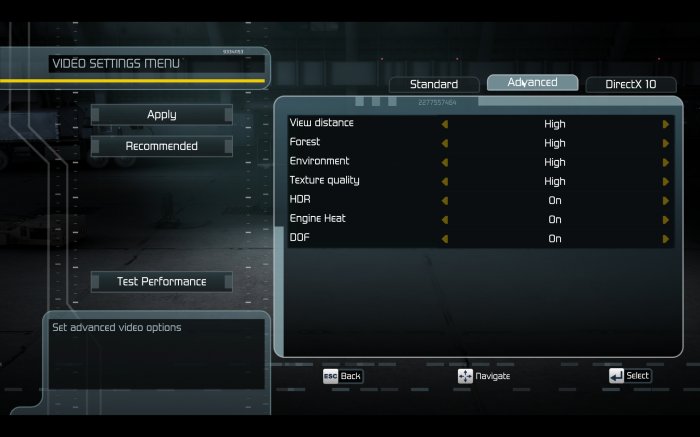
HAWX is another game where Nvidia cards often have better performance. It is unsurprising that we see the GTX 460 1GB taking a commanding lead. In fact, the GTX 460 1GB out-performs both the HD 6850 and HD 6870.
The same performance scaling that we have observed continues with this benchmark where the 1120 shader units offer 5% gain over the reference HD 6850, and the HD 6870 offers 10% gain over the 1120 shader unit HD 6850. The CrossFire setup allows us to have 40% performance gain over the HD 6870, narrowly beating out the GTX 480 at 1920×1200 resolution.
Dirt 2
Colin McRae: Dirt 2 (known as Dirt 2 outside Europe and stylized, DiRT) is a racing game released in September 2009, and is the sequel to Colin McRae: Dirt. This is the first game in the McRae series since McRae’s death in 2007. It was announced on 19 November 2008 and features Ken Block, Travis Pastrana, Tanner Foust, and Dave Mirra. The game includes many new race-events, including stadium events. Along with the player, an RV travels from one event to another, and serves as ‘headquarters’ for the player. It features a roster of contemporary off-road events, taking players to diverse and challenging real-world environments. The game takes place across four continents: Asia, Europe, Africa and North America. The game includes five different event types: Rally, Rallycross, ‘Trailblazer,’ ‘Land Rush’ and ‘Raid.’ The World Tour mode sees players competing in multi-car and solo races at new locations, and also includes a new multiplayer mode.
Colin McRae: Dirt is the first PC video game to use Blue Ripple Sound’s Rapture3D sound engine by default.
A demo of the game was released on the PlayStation Store and Xbox Live Marketplace on 20 August 2009. The demo appeared for the PC on 29 November 2009; it features the same content as the console demo with the addition of higher graphic settings and a benchmark tool.
Dirt 2 is our last set of benchmarks where we look at the performance scaling of the AMD cards for DirectX 11. Again, the same trends have been observed here, with the 1120 shader unit of HD 6850 continuing to offer about 5% gain over the HD 6850.
POWER CONSUMPTION
To get our power consumption numbers we plugged in our Kill A Watt power measurement device and took the Idle reading at the desktop during our temperature readings. We left it at the desktop for about 15 minutes and took the idle reading. Then we ran Furmark for 10 minutes and recorded the highest power usage.
The latest generation of AMD cards all consume about the same amount of power under idle. The Sapphire HD 6850 actually consumes 3 watts more than either the HD 6850 or the HD 6870.
Under load, the HD 6850 consumes 255 watts, while the 1120 shader version of the card consumes 27 watts more, and the HD 6870 consumes 36 watts more. If we account for the power consumption of these cards, we can see that while the 1120 shader unit HD 6850 is able to yield 5% performance gain over the reference HD 6850. The HD 6870 actually is a more efficient card because for 10 more watts, we get about 15~20% gain over the HD 6850.
It is worth noting that the CrossFire setup of the HD 6870 and HD 6850 consumes 415 watts, 30 watts more than the HD 5870. Based on the performance, the latest generation of cards is far more power-efficient. Pairing up two of these cards only raises our power consumption by 30 watts, yet it is capable of offering 20~30% performance over the single HD 5870. In a few benchmarks, we also notice the CrossFire of HD 6870 and HD 6850 offers performance comparable to the two HD 5870 in CrossFire.
Conclusion
After putting the retail HD 6850 through our gruesome tests and showing the performance of the retail card, we feel that the HD 6850 still offers a good choice for mainstream users. While the card may not always come out on top, compared to the GTX 460 1GB, it is nonetheless able to offer competitive performance and good power consumption.
We still like how cool and quiet the Sapphire HD 6850 is, and we feel that users who buy an HD 6850 would not regret the choice.
 Bjorn3D.com Bjorn3d.com – Satisfying Your Daily Tech Cravings Since 1996
Bjorn3D.com Bjorn3d.com – Satisfying Your Daily Tech Cravings Since 1996


